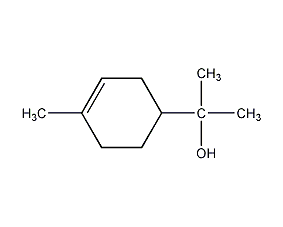
Structural formula
| Business number | 02E3 |
|---|---|
| Molecular formula | C10H18O |
| Molecular weight | 154.24 |
| label |
α,α-4-trimethyl-3-cyclohexene-1-methanol, 2-(4′-Methyl-3′-cyclohexenyl)-2-propanol, 1-p-menthene-8-ol, terpineol, 1-p-Menthen-8-ol, 2-(4-Methyl-3-cyclohex-3-enyl)-propan-2-ol, α,α-4-Trimethyl-3-cyclohexene-1-methanol, p-Menth-1-en-8-ol, flavors and fragrances, alcohol solvent |
Numbering system
CAS number:98-55-5
MDL number:MFCD00001557
EINECS number:202-680-6
RTECS number:WZ6700000
BRN number:1906604
PubChem ID:None
Physical property data
1. Properties: colorless liquid.
2. Density (g/mL, 20℃): 0.934
3. Relative vapor density (g/mL, air=1): Undetermined
4. Melting point (ºC): 40-41
5. Boiling point (ºC, normal pressure): 219~221
6. Boiling point (ºC, 20mmHg):
7. Refractive index (n20D): 1.483
8. Flash point (ºC) : 90
9. Specific rotation (º): Undetermined
10. Autoignition point or ignition temperature (ºC):
11. Vapor pressure (mmHg, 40ºC): Undetermined
12. Saturated vapor pressure (kPa, 25ºC): Undetermined
13. Heat of combustion (KJ/mol): Undetermined
14. Critical temperature (ºC): Undetermined
15. Critical pressure (KPa): Undetermined
16. Oil-water (octanol/water) distribution coefficient Log value: Undetermined
17. Explosion upper limit (%, V/V): Undetermined
18. Explosion lower limit (%, V/V): Undetermined
19. Solubility: Undetermined
Toxicological data
1. Acute toxicity: rat oral LD50: 5170mg/kg; mouse oral LD50: 2830mg/kg; mouse muscle LD50: 2mg/kg; 2. Other multi-dose toxicity: rat oral TDLo: 7755mg/kg /30D-I;
Ecological data
This substance is slightly hazardous to water.
Molecular structure data
1. Molar refractive index: 47.07
2. Molar volume (cm3/mol): 164.9
3. Isotonic specific volume (90.2K): 396.0
4. Surface tension (dyne/ cm): 33.2
5. Dielectric constant:
6. Dipole moment (10-24cm3) :
7. Polarizability: 18.66
Compute chemical data
1. Hydrophobic parameter calculation reference value (XlogP): 1.8
2. Number of hydrogen bond donors: 1
3. Number of hydrogen bond acceptors: 1
4. Number of rotatable chemical bonds: 1
5. Number of tautomers:
6. Topological molecular polar surface area (TPSA): 20.2
7. Number of heavy atoms: 11
8. Surface charge: 0
9. Complexity: 168
10. Number of isotope atoms: 0
11. Determine the number of atomic stereocenters: 0
12. Uncertain number of atomic stereocenters: 1
13. Determine the number of chemical bond stereocenters Number: 0
14. Number of uncertain chemical bond stereocenters: 0
15. Number of covalent bond units: 1
Properties and stability
1. It does not decompose under normal temperature and pressure. Avoid contact with alkalis, amines, alkaline earth metals, oxidants, acid chlorides, acid anhydrides, and metal powders.
2. Exist in mainstream smoke.
Storage method
Stored in a cool, ventilated warehouse. Keep away from fire and heat sources. The packaging is sealed. should be kept away from oxidizer, do not store together. Equipped with the appropriate variety and quantity of fire equipment. Suitable materials should be available in the storage area to contain spills.
Synthesis method
1. Prepared by the condensation reaction of isoprene and butenone, and then reacting with Grignard reagent; or from pinene in turpentine in 30% Under the action of sulfuric acid, hydrated terpene diol crystallizes and precipitates, and after separation, the finished product is obtained through dehydration, separation and distillation.
2. Isolated and extracted from longleaf pine.
Purpose
Terpineol is mainly used in fruit flavors such as lemon, sweet orange, strawberry, and peach. Generally in chewing gum 40mg/kg; in flavorings 38mg/kg; 14mg/kg in candies; 19mg/kg in baked goods; 16mg/kg in cold drinks; 12~16mg/kg in puddings ;5.4mg/kg in soft drinks

 微信扫一扫打赏
微信扫一扫打赏

